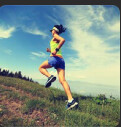Running News Daily
Running News Daily is edited by Bob Anderson. Send your news items to bob@mybestruns.com Advertising opportunities available. Train the Kenyan Way at KATA Kenya and Portugal owned and operated by Bob Anderson. Be sure to catch our movie A Long Run the movie KATA Running Camps and KATA Potato Farms - 31 now open in Kenya! https://kata.ke/
Index to Daily Posts · Sign Up For Updates · Run The World Feed
How to Properly Prepare for Hot-Weather Races
Ah, summertime! It's one of the best seasons for long trail runs, but it's also the hottest and one of the most difficult times to train.
As temperatures and UV indices climb, runners in many regions can feel the dew point explode, and that can make it seem like any semblance of fitness gained over the winter and spring is suddenly gone. We can all recall an early summer run that makes us not only question our confidence, but whether we're going to make it through the next few months.

There are notoriously warm races on the horizon, and there's a lot of talk about heat and how to mitigate it: sauna training, layering, topical cooling-all the tools to get amateur and elite athletes alike through challenging conditions. Many of the runners who just raced the Western States 100 had relied on mid-afternoon runs when temperatures were at their highest, as well as sauna or hot water immersion training. The race, as with many other summer and early fall races, typically boasts soaring high temperatures along sections at lower elevations.
For decades, the three most-watched sporting events worldwide-the Summer Olympics, FIFA World Cup, and the Tour de France-are typically held during the hot summer months of the Northern Hemisphere. However, prior to 2012, most of the scientific literature on heat acclimation for athletes was based on laboratory testing and controlled environments, and not from real competitions in scorching conditions. With eight of the hottest years in recorded human history having been logged since 2015, global sport organizations such as the International Olympic Committee have finally placed enormous emphasis on providing up-to-date guidelines and recommendations in order to keep athletes safe.
The COVID-19-delayed Tokyo Olympics in 2021 were the hottest Games in modern history with temperatures soaring into the mid-80s and humidity hovering at 82 percent during the women's marathon. The good news is that it sparked considerable discussion and hypothesizing in sport-science communities about best ways for the athletes and their teams to prepare and endure heat. Ultrarunners everywhere watched as the world's best distance runners implemented topical cooling techniques such as pre-competition ice vests and bags of ice during the marathon-a relatively new or at least a more aggressive tactic to attenuate the impact of heat before and during competition.
Heat is considered an equalizer, an element that everyone has to manage, no matter if you're attempting to train or race through it. But does it have to be a performance-sapping equalizer? Can heat training (potentially year round) be viewed as an opportunity to improve fitness, tolerance, and mental strength for challenging race day conditions?
How Heat Impacts Performance
First up, let's discuss what happens when athletes exercise in the heat. Blood flow to the skin, as well as sweat rate, increase to promote heat dissipation. While aimed at keeping the human body safe, these processes increase physiological strain and the chance for dehydration in prolonged endurance events, leading to a subsequent increase in cardiovascular strain. This creates a chain reaction that negatively impacts aerobic performance. Researchers globally agree that the most salient way to lessen the strain that heat imposes is to perform a heat acclimation period ahead of race day.
Improvements in aerobic performance and thermal comfort achieved through heat acclimation are bolstered by these processes, as outlined in a 2011 scientific article from the U.S. Army Research Institute of Environmental Medicine.
Heat Acclimation
Let's dive even further into what the science says about heat acclimation, when and how to implement it, and what athletes of all levels can do to mitigate heat stress before, during, and after exposure to a hot endurance event.
A study published in the British Journal of Sports Medicine in 2015 provided the first-of-its-kind, gold-standard consensus recommendations for heat acclimation, and remains one of the most cited pieces of recent literature regarding training and competing in heat, along with Julien Periard's comprehensive review from 2021 for the American Physiological Society. In both reviews, the authors discuss heat acclimation, hydration, and cooling strategies as the pillars of successfully competing in the heat.
The authors report that most adaptations happen within the first week and more slowly within the following ten days. In order to achieve near complete adaptations to fully optimize aerobic performance, athletes need to plan for two weeks of focused acclimation. A pre-Tokyo Olympics study from 2020 suggests following the gold standard of 10-14 days of long-term heat acclimation followed by a shorter five-day reacclimation period just ahead of competition (during the taper period) in order to get the most out of "peak weeks" of training without compromising the health of the athlete with the added stressor of heat training.
It is important to note that the average loss of heat acclimation is roughly two-point-five percent per day following 48 hours without exposure to heat. But reacclimation happens quickly. The rate of decline varies from individual to individual and typically occurs at a slower rate than induction to heat acclimation.
The literature favors training in the same environment as the upcoming race, and if that isn't possible, training indoors in a heated room is the next best option. These once-a-day sessions should last at least 60 minutes, at an easy effort, while keeping a close eye on heart rate (preferably at about 75 percent of max heart rate). Athletes should expect to see their heart rate decrease as adaptations continue to occur, and as such, the duration or intensity of the session should be increased in order to maintain the training stimulus.
What if you don't have access to the same outdoor environment nor the set-up to train in a heated room? A study from 2007 demonstrated that 12 sessions of post-exercise sauna bathing at approximately 190 degrees Fahrenheit for 30 minutes at a time over the course of three weeks enhanced endurance performance.
What about dry heat versus humid heat and acclimating to either? The science demonstrates that acclimating to dry heat improves exercise in humid heat and vice versa. But acclimating in humid heat evokes higher skin temperatures and circulatory adaptations. In other words, the stereotypical dad statement: "But it's a dry heat!" holds somewhat true.
Are there benefits to heat acclimation when your race is in temperate or cool environments? A study from 2010 on cycling performance demonstrated a five percent increase in VO2max in cool conditions versus an eight percent increase in hot; a six percent improvement in time-trial performance in cool conditions vs. an eight percent improvement in hot; and an equal increase in power output at lactate threshold in both cool and hot conditions of five percent.
Hydration
Training in hot conditions increases sweat rate, which leads to progressive dehydration (if fluid intake is not increased), causing a similar cascading effect that is essentially the reverse of what happens during heat acclimation: decrease in plasma volume, evaporative heat loss, and cardiac filling all leading to a reduction in capacity to tolerate the effort in the heat.
A 2015 study in the British Journal of Sports Medicine underscores the importance of starting training or competition in the heat in a well-hydrated state with sodium supplementation before and during the event, minimizing body water mass losses during prolonged exercise in the heat, and being sure recovery hydration regimens include sodium, carbohydrates, and protein.
A 2010 study published in the Journal of Applied Physiology demonstrated enhancement and acceleration of heat adaptations, as well as further increases in blood plasma volume by taking in a protein-carbohydrate mix (0.3g of protein/kg of body weight and 3.6kcal of carbohydrate/kg of body weight) within 10 minutes of heat training.
Cooling Strategies
Numerous studies underscore that cooling strategies implemented immediately before, during, or after competition should be used in addition to heat acclimation, not as substitutes. Cooling strategies provide the most benefit during sustained exercise, but should not be used for sprinters. They include both external methods like ice bandanas and saturated towels, cold water immersion, fanning, topical menthol sprays, and internal options such as the ingestion of cold fluids or ice slurries. (Did someone say post-run slushies?!)
Ice bandanas and saturated towels demonstrate the ability to lower skin temperature (without lowering muscle temperature and risking injury) and effectively lower cardiovascular strain. Ice slurries have been shown to be more effective at cooling athletes than cold fluid ingestion, as the latter has also shown reductions in sweating and evaporation. The literature encourages combining techniques (external and internal), as doing so has a higher cooling capacity than the same techniques used in isolation.
A meta-analysis from 2020 found that topical menthol spray caused cooler thermal sensation and improved thermal comfort, but no significant differences in sweat production, core temperature, or heart rate were demonstrated. Findings showed external application, warmer environment, and higher body mass indices as improving menthol's effects on endurance performance without compromising the body's response to the heat.
How to Apply This in Training?
For athletes targeting a warm or hot race, we have a few options in how to structure heat acclimation. As a coach, I recommend against adding in heat acclimation as a novel stimulus without an anticipated hot race on the calendar, because most athletes still have a lot of other low-hanging fruit to grab first. (Looking at you, quality sleep!). If you are a highly trained athlete, chat with your coach prior to initiating heat acclimation in the absence of a warm-weather event on your schedule.
If you have a history of RED-S (Relative Energy Deficiency In Sport), work closely with your coach and medical team to be absolutely certain you aren't adding in too much stress to your training all at once. Taking body weight measurements can be a part of hydration monitoring, but it's important to contemplate the pros and cons of doing so. Another consideration is making sure you have a clear picture of your iron/ferritin status prior to initiating a robust heat acclimation protocol, as iron is lost through sweat.
by Trail Runner Magazine
Login to leave a comment




